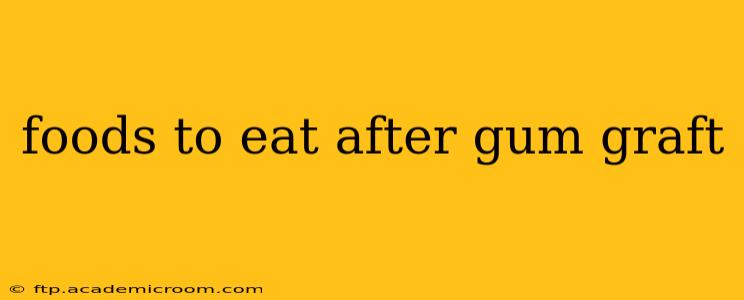A gum graft, also known as a gingival graft, is a surgical procedure used to treat gum recession, where the gum tissue pulls back from the teeth, exposing the roots. Recovery after a gum graft requires careful attention to diet to promote healing and minimize discomfort. This guide will detail the best foods to eat after a gum graft, answer common questions, and provide tips for navigating your post-operative diet.
What Can I Eat After a Gum Graft?
The first few days after your gum graft are crucial for healing. You'll need a diet consisting of soft, easily chewable foods that won't irritate the surgical site. Here's a breakdown of suitable options:
- Soft fruits: Mashed bananas, applesauce, ripe peaches, and berries are all excellent choices. Avoid anything with seeds or hard pieces.
- Yogurt and smoothies: These are packed with nutrients and are easy to swallow. Opt for plain yogurt and add your own fruit purees for extra flavor and nutrition.
- Soups: Broth-based soups are ideal, but avoid those with chunky vegetables or noodles that could irritate the graft. Pureed soups are even better.
- Scrambled eggs: Soft scrambled eggs provide protein for healing.
- Oatmeal: Cooked oatmeal is gentle on the gums and provides fiber.
- Pasta: Well-cooked pasta, without any hard or crunchy additions, can be a good source of carbohydrates. Choose smooth sauces.
- Mashed potatoes: A classic soft food option that is easy to digest and nutritious.
- Pureed vegetables: Puree carrots, sweet potatoes, or other soft vegetables for added nutrients.
What Foods Should I Avoid After a Gum Graft?
It's equally important to know what to avoid to prevent complications and discomfort:
- Hard foods: Anything that requires significant chewing, like nuts, chips, hard candies, and raw vegetables, should be strictly avoided.
- Spicy foods: Spicy foods can irritate the healing gums and cause pain.
- Acidic foods: Citrus fruits, tomatoes, and other acidic foods can also irritate the surgical site.
- Alcohol and tobacco: These substances hinder healing and increase the risk of infection. Avoid them entirely during your recovery period.
- Extremely hot or cold foods: These temperature extremes can be uncomfortable and may increase sensitivity in the area.
How Long Should I Eat Soft Foods After a Gum Graft?
The duration of a soft food diet after a gum graft varies depending on individual healing rates and the extent of the procedure. Generally, you should stick to a soft food diet for at least the first week, gradually reintroducing firmer foods as your gums feel more comfortable. Your periodontist will provide specific dietary recommendations during your post-operative consultation. Always follow their instructions carefully.
What are the Best Nutrients for Gum Graft Healing?
A balanced diet rich in specific nutrients is vital for optimal healing. Focus on foods containing:
- Protein: Essential for tissue repair. Good sources include eggs, yogurt, and lean meats (once you can comfortably chew them).
- Vitamin C: Crucial for collagen production, which is essential for wound healing. Find it in citrus fruits (once healed), berries, and bell peppers (in pureed form initially).
- Calcium: Important for bone health and overall healing. Dairy products (once you can manage them) and leafy greens (pureed initially) are good sources.
Can I Drink Through a Straw After a Gum Graft?
It's generally recommended to avoid drinking through a straw after a gum graft, as the suction can disrupt the blood clots and potentially cause complications. Drink liquids directly from a cup or glass.
Will My Diet Affect My Gum Graft Healing?
Yes, your diet plays a significant role in the healing process. A nutritious, soft food diet minimizes irritation, promotes healing, and reduces the risk of infection. Following your periodontist's dietary guidelines is crucial for a successful recovery.
What if I Experience Pain or Discomfort While Eating?
If you experience significant pain or discomfort while eating, stop immediately and consult your periodontist. They may adjust your post-operative care plan or suggest alternative foods.
By following this guide and adhering to your periodontist's instructions, you can ensure a smoother recovery after your gum graft and enjoy a healthy, delicious diet throughout the healing process. Remember, patience and proper nutrition are key to successful healing.
